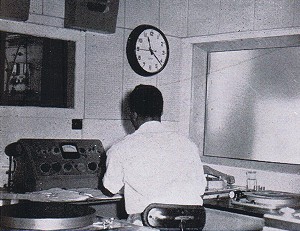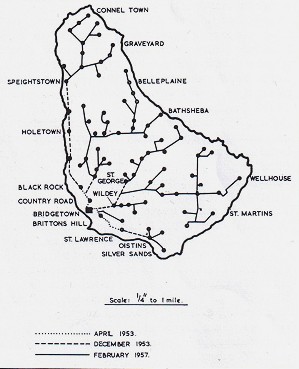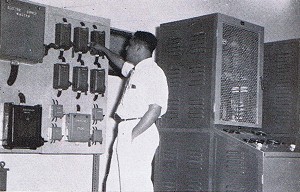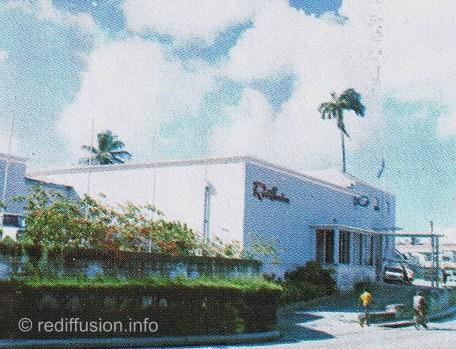


The method is very similar to the block cabling used in the U.K. and elsewhere and has over the years proved itself to be simple, efficient and economical. Naturally all was not plain sailing as Barbados had some peculiar problems of its own. It should be ex-
plained that the average worker’s or peasant’s house was basically a simple 9ft. x 16ft. wooden structure about 11ft. high with some modifications to suit the size of the family. Between Oistins and Speightstown there was practically a continuous ribbon of these houses and elsewhere in the island they are clustered into villages varying from 12 to 300 houses in size. As soon as the
owner has accumulated enough wealth he might replace all, or part, of his wooden house with a more substantial home of coral or concrete blocks. If a householder decided to move it was not uncommon for him to get a few of his friends to help him lift and carry the wooden home to a new location.
Wayleaves had to be obtained from each individual householder and it was usually readily given. Difficulties arose, however, if the owner wa a member of one of the stricter religious sects with which Barbados abounds. These people had strong views on such things as dancing, film, radio, etc. and would actually oppose the extension of the Rediffusion network on or even over their houses.
Subscribers who were disconnected for arrears had a habit of demanding the instant removal of all wiring from their homes even if this means depriving all their neighbours of service as well. It speaks well of the tact and skill of the wiring staff that these problems were met cheerfully and very seldom involved inconvenience to other subscribers.
From 1954 on, the network development had been rapid and extended to every town and hamlet on the Island and the experienced help of Mr. B. van Ryn, Chief Engineer, Rediffusion (Wales) Ltd. was forthcoming for this work. Over 225,000 route yards of H.L.L.
were by now in use and some 736,000 route yds. of feeder.
The H.L.L. system by now operated at ten times service level and fed over 80 H.L.L. kiosks. Power was supplied by three A.160 amplifiers (a successful local modification of original A.50’s) soon to be augmented by two similar units from London. At the end of 1956 the subscriber total had reached 16,426 and service was available to over 50,000 houses. In the city areas open wire H.L.L.s had been replaced with star quad and the system as it stood could cope with a connected load of 20,000 subscribers.
Modifications already planned would increase the capacity to 25,000 subscribers.
Programmes, largely commercial, were originated in the Company’s Studios although some sustainer material was presented from transcriptions or tapes from various sources and by direct relay of the B.B.C.
Programming included: The Fire Fighters, Journey into Space, Portia Faces Life, Second Spring, Mary Layne which later became Aunt Mary, Doctor Paul, Life Can be Beautiful with Pappa David, Stephen Hamilton and Chie Chie. Then there was the Goon show, A life of Bliss, The Clithero Kid, starring Jimmy Clithero and the Navy Lark. There was also Flying High with Jim Kidd and Joe Tudor and the Mighty Charmer; then for the children there was the Children Party with Aunty Pat (Pat Carpenter) on Saturday mornings. Women had a show called 'Women's World' with Carolyn Barrow. There were two studios in use, one used as a continuity studio, and a larger one for the origination of dance music, local talent, etc. with audiences.
The continuity studio had facilities for pre-cueing and mixing inputs from four transcription units, two tape recorders, microphones, receiving stations, outside broadcast points, etc., and is equipped with the usual talk back and telephone facilities. The larger studio was equipped with a severely modified Redifon console of early design and duplicated the essential facilities of the continuity studio. A small recording room with tape recorders and a disc recorder was also provided and Rediffusion had often been complimented by visiting B.B.C. producers appreciative of the high standards of efficiency provided by the operating staff and equipment.
All recording equipment and outside broadcast equipment, together with the receiving station and amplifying equipment was maintained and serviced by a staff of three engineers under the direction of Mr. F. G. Duesbury, the Equipment Engineer.
Maintenance and some other vehicles were equipped with V.H.F. radio telephone sets.
The Rediffusion single programme network covered the entire island, an area of 166 sq.miles and the V.H.F. equipment enabled the
Company to reduce the average time of fault clearance from 3 hrs. to 1/2 hr.
With the exception of the General Manager, Programme Manager and the E.I.C. all the staff were recruited locally and Rediffusion was proud of the fact that all technical, wiring and operating staff were Barbadian, practically all trained by the Company itself.
The staff now numbered 104 split into the usual departments of Accounts, Engineering, Programming, Advertising and Rental Collection.
In September 1979, the Nation Corporation purchased Barbados Rediffusion Services Ltd., enabling the company to expand its broadcasting division through the launch of its second radio station, Voice of Barbados (790 VOB) on May 1st, 1981.
In October 1997 it was announced that an era of broadcasting would come to an end with the closure of Barbados' lone wired radio service, Star Radio. General Manager of Barbados Rediffusion Services Ltd Vic Fernandes said the 62 year-old service was not financially viable and would be closed on 30th November. Possibly the last remaining Rediffusion wired service to close down
Associated Companies in over 175 towns in Great Britain and in Barbados, Bermuda. Canada, Ceylon, Guyana,
Hong Kong, Jamaica, Malaya, Malta, Singapore, South Africa, Trinidad and West Africa etc.
River Road, Bridgetown
Barbados

Barbados Rediffusion Service Ltd.
I am looking for information on Rediffusion Barbados Ltd
Did you work there ? What are your memories ?
Do you have any old pictures of the Building, Staff etc.
Please share them with us.
SEARCH
Use the "Search Box" to search the whole Rediffusion Website for: Names, Branches, Company Details, Technical and much more
REDIFFUSION BARBADOS
Wired Broadcasting in Barbados commenced in 1934.The Company was formed on October 24th, 1934, under the name of Radio Distribution (Barbados) Ltd. The first manager was Mr. H.J. Witnell and on April 2nd, 1935, the first subscriber was connected to Cable Radio in Barbados. The service comprised relays of programmes from the BBC and other short wave stations in America and Canada.
By 1947 when the number of subscribers had risen to 1,800, a studio was built in the Bridgetown premises and regular broadcasts commenced.
Technical support for the service in Barbados supplied by the UK company Broadcast Relay Service Ltd., the owner of Rediffusion.
In the late 1940's, Rediffusion had sought to expand it's cable relay business overseas with systems already being installed
in Malta, Hong Kong, Singapore and Montreal Canada.
In Jan. 1951 Overseas Rediffusion Ltd. acquired the controlling interest in Radio Distribution (Barbados) Ltd. which had existed in the Island since 1934. The Company went into voluntary liquidation and on 1st Feb. 1951, Barbados Rediffusion Service Ltd. came into being. The organisation continued to operate from it's small facility in Trafalgar Street but in 1958 re-located to much larger premises in Riverside Road, Bridgetown with new studios, programme department and a record library.
Subscribers on service totalled only 4,200 located in the capital town of Bridgetown. The main amplifying station consisted of one A.50, there was no H.L.L. system but trunk telephone lines were rented, running two miles north and south to carry the programmes to 200W. amplifiers at two distribution points. All feeders ran from these and the main station. The network was
generally open wiring, several years old.
History



The overall arrangement was unsatisfactory and in 1952 plans were made
for the construction of a H.L.L. system with the objects of freeing the
Company from dependence on telephone lines, facilitating E.D.O.L. and
providing for future expansion.
By April 1953 the network had assumed the general shape and coverage
shown on the map and the subscriber total was 6,381. The H.L.L. system
was operating at five times service level, three A.50 amplifiers providing
the power. A solitary booster amplifier was still in use at Wildey and the
decision had been taken to extend the Black Rock H.L.L. northwards as
far as Speightstown to take service to the almost continuous ribbon of
houses between the two points. This work commenced in July 1953 and
at the same time the H.L.L. system was converted to seven times service
level. The booster amplifier at Wildey was removed and the system at last
began to resemble the more conventional and efficient U.K. distributions.
Sept. 1953 saw the installation of Rediffusion in Speightstown and the
completion (at that time) of the longest H.L.L. in existence. There were
six kiosks on the link and, in addition to minor feeder development, by the
end of the year the subscriber total had jumped to 7,582. For economic
reasons it was decided that H.L.L. extensions should be confined to
existing pole routes which belonged to either the Telephone or Electricity
companies with whom agreements had been made to use such of their
poles as were necessary. Although H.L.L.s were confined to pole routes it
was soon apparent that a radical change in method was needed to deal
with feeder development, for, once off the main roads, few poles were to be
found to carry the service to side streets and houses. Extensive use was
therefore made of house to house wiring for the first time (although some
use of it had been made in a few city districts).
Map of Barbados showing rapid development of the wired network in the 1950's
One of the new studios used by Rediffusion Barbados showind turntables console and tape recorder.
The Senior Equipment Engineer, Mr F G Duesbury at the control panel with the A.160 amplifiers on the right.
Headquarters in Barbados Pictured in 1969

Do You Remember Norman Wood ?
Norman Wood lived with his wife Madge and 2 children Veronica and Richard in Barbados from 1948 to 1951. He was Administration Secretary to the Director General of Civil Aviation. Also Secretary to a committee which was set up to make recommendations regarding the future development of the Seawell Airport.
He was also a popular announcer with Barbados Rediffusion Service Ltd with a regular show called "Uncle Norman". His daughter Veronica once sang "Teddy Bear's Picnic" on that show.
He was a polished and talented actor in the flourishing Amateur Dramatic Society called the Barbados Dramatic Club which he founded.
They lived at Brittons Nursing home, Brittons Hill, where Madge was a nurse.








